We’d like to remind Forumites to please avoid political debate on the Forum.
This is to keep it a safe and useful space for MoneySaving discussions. Threads that are – or become – political in nature may be removed in line with the Forum’s rules. Thank you for your understanding.
The MSE Forum Team would like to wish you all a Merry Christmas. However, we know this time of year can be difficult for some. If you're struggling during the festive period, here's a list of organisations that might be able to help
📨 Have you signed up to the Forum's new Email Digest yet? Get a selection of trending threads sent straight to your inbox daily, weekly or monthly!
Has MSE helped you to save or reclaim money this year? Share your 2025 MoneySaving success stories!
Health Hazard ongoing home solutions
Henrta
Posts: 34 Forumite



I am looking for UK based services in the North West, that test to conclusively identify with empirical evidence what is in the air that is causing my consistent respiratory, mind fog and itching scratchy eye symptoms.
Detailed fuller story below:
My father passed away last year (unidentified re-occurring infections, now seems possibly connected to this). There were two damp issues caused from a leaking toilet downstairs and leaking repairs needed in the roof above.
After the 6 month illness, mostly at home until the end, he passed away. I then started to try and resolve the damp issues that I had ignored while taking care of him (and for some time before, in all honesty).
I opened up slightly the skirting board in the kitchen next to the leaking toilet to assess (leak in toilet had seeped through to kitchen wall). It was hidden but slugs were constantly entering at night. The next day after exercising downstairs in that area, I had signs of a chest infection. I recovered, but since have had the mind fog, respiratory and itching eyes consistently on and off for the past 5 months. While attempting to combat the issue I have a hepa air purifier that perhaps is helping in my room (I know this is not a long term solution, it is for the fixing period), but if I leave, even with a p100 mask on and goggles, I begin to suffer. I am attempting to find realistic consistent living conditions close by, while solving the issue, but it is difficult.
I presumed it was mould. Now I am not so sure and would like to conclusively have the answer. I am thinking perhaps it is asbestos or another unidentified source (Insulation Fiberglass or Foam for instance) as there is insulation in the roof. Or perhaps some combination.
White packing balls are all over the house in various rooms and the loft, sometimes coming from unidentified areas. These I presume, are all connected to the water damage.
I am extremely concerned, that within the walls there is damage, and that asbestos or other dangers can not be ruled out in areas that cannot be seen. This is why I would like a professional to identify the cause via the air itself, or some other empirically verifiable method.
The toilet has been removed and replaced. The roof leak has been repaired. But there is still some damage to the roof while insurance prepare to assess it.
Selection of images:
This is the foam in the loft that has suffered from water damage. Are these materials potentially dangerous when water damaged? Or dangerous full stop?
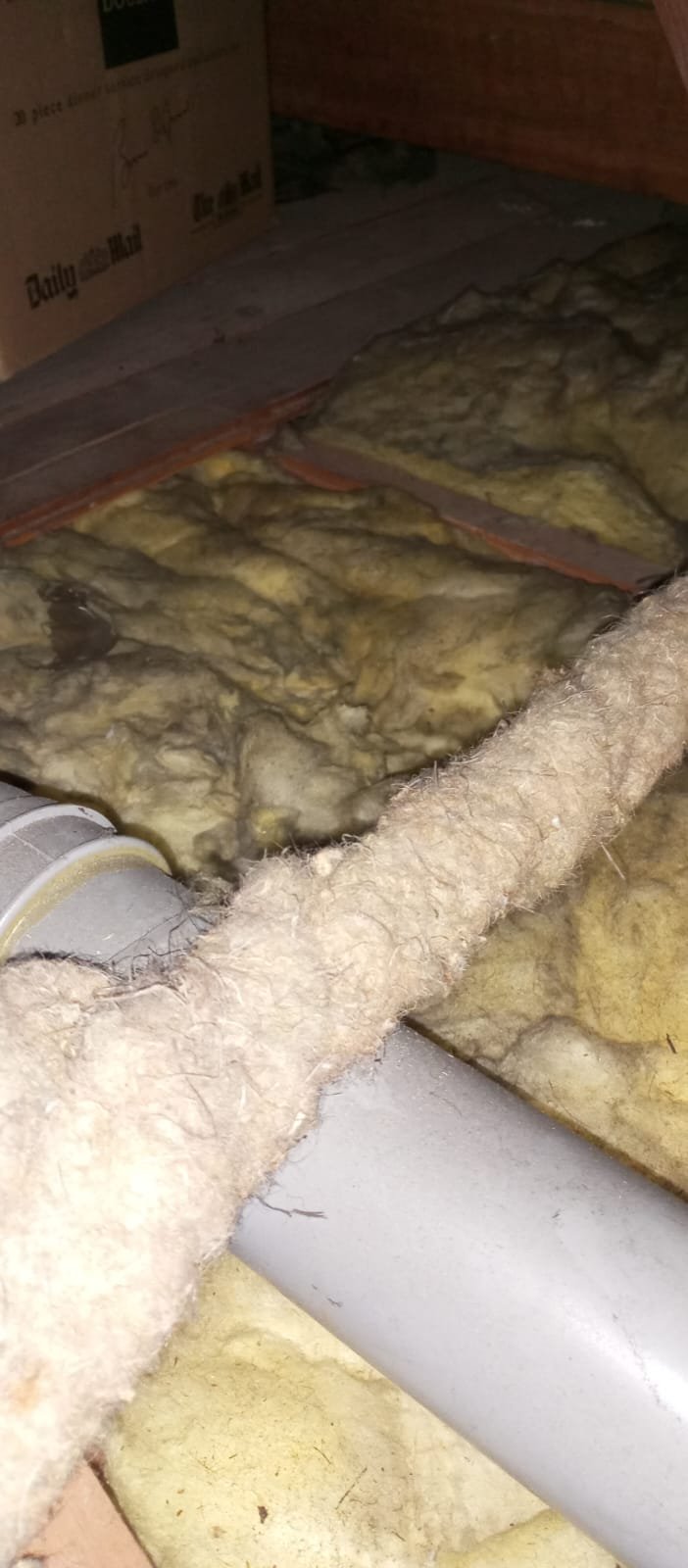


Here is a picture of a wasp nest discovered there (seems long abandoned, though it is winter). Not sure if dangerous when matched with water damage. This is a before and after roof fix. It seems to have reduced it size. Not sure if its degradation is causing issues.
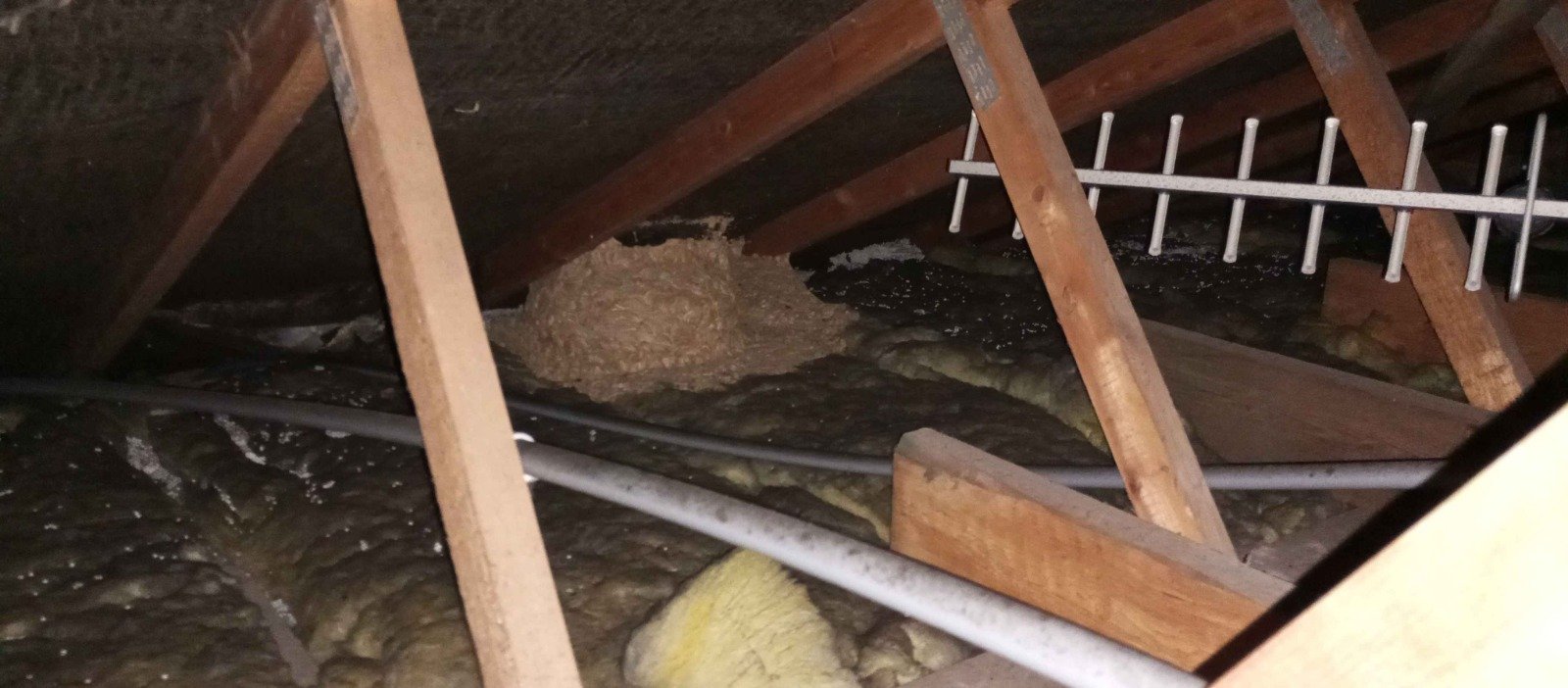
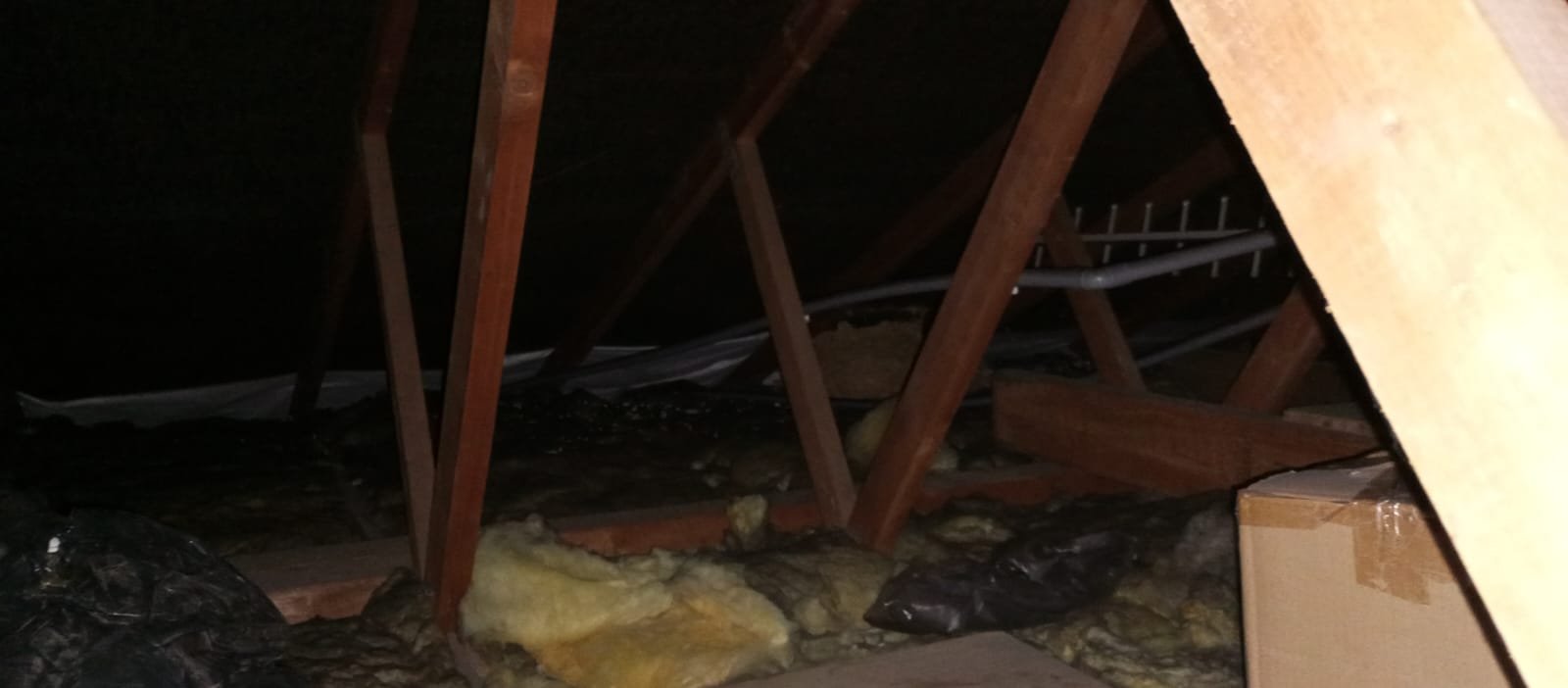


Here is some mould damage that roughly corresponds under area where the loft wasp nest is.
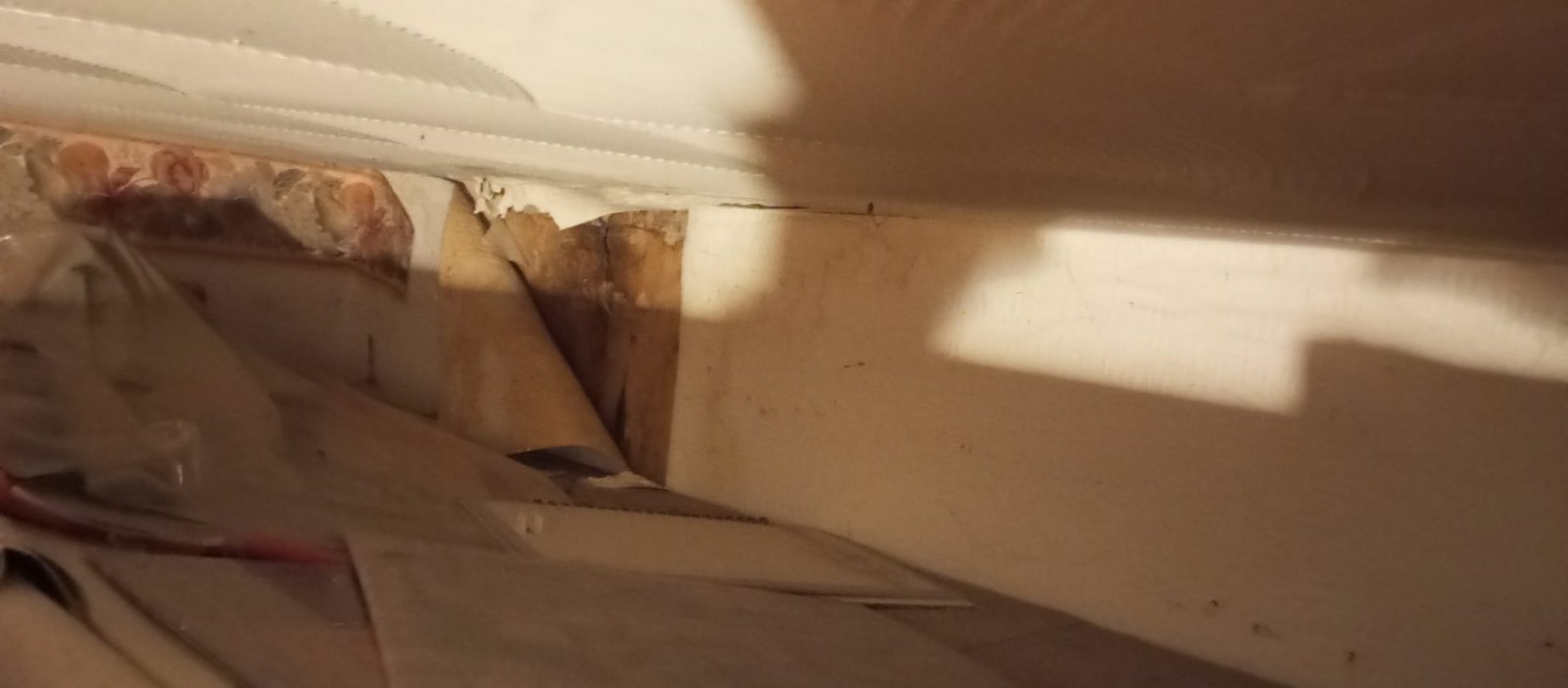
This is the area where the skirting board was taken off. Do these walls look potentially dangerous if exposed to persistent long term water damage, as they have been?
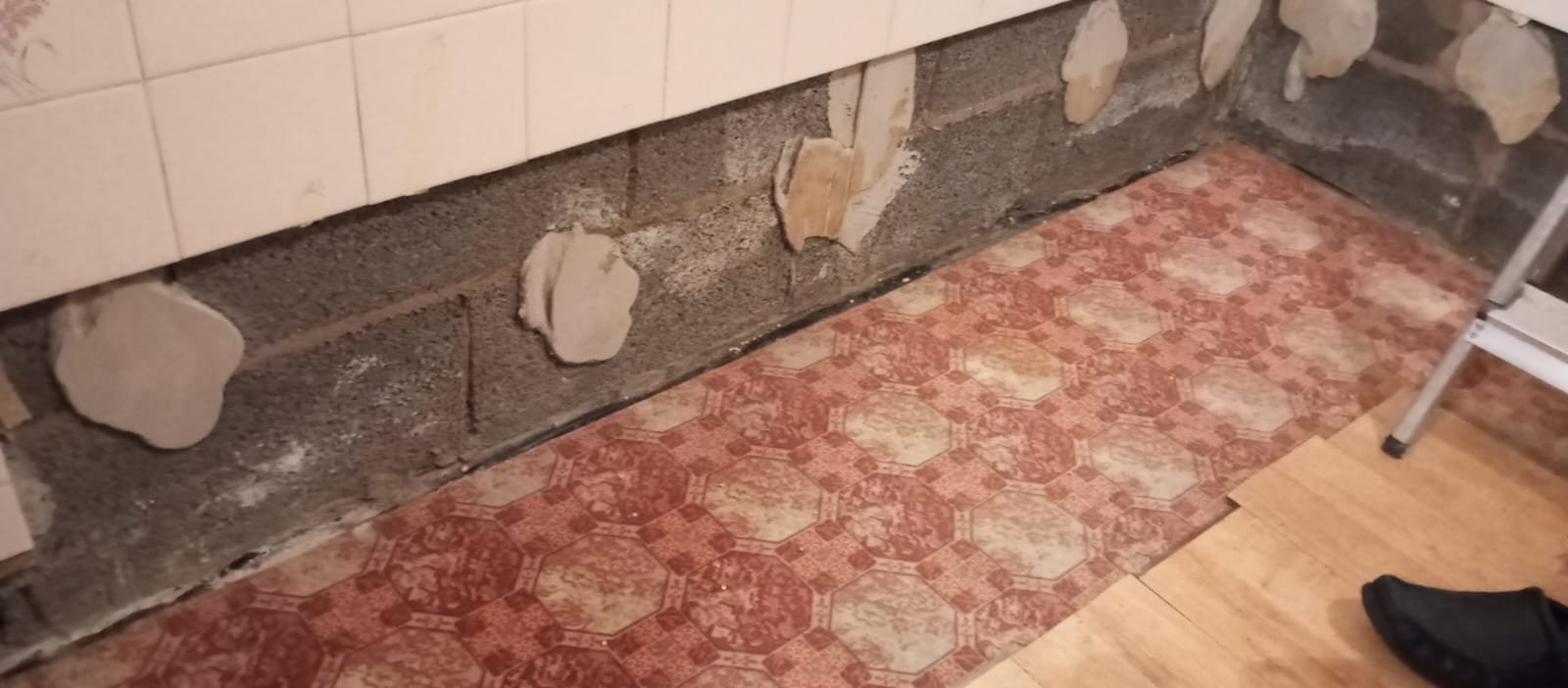
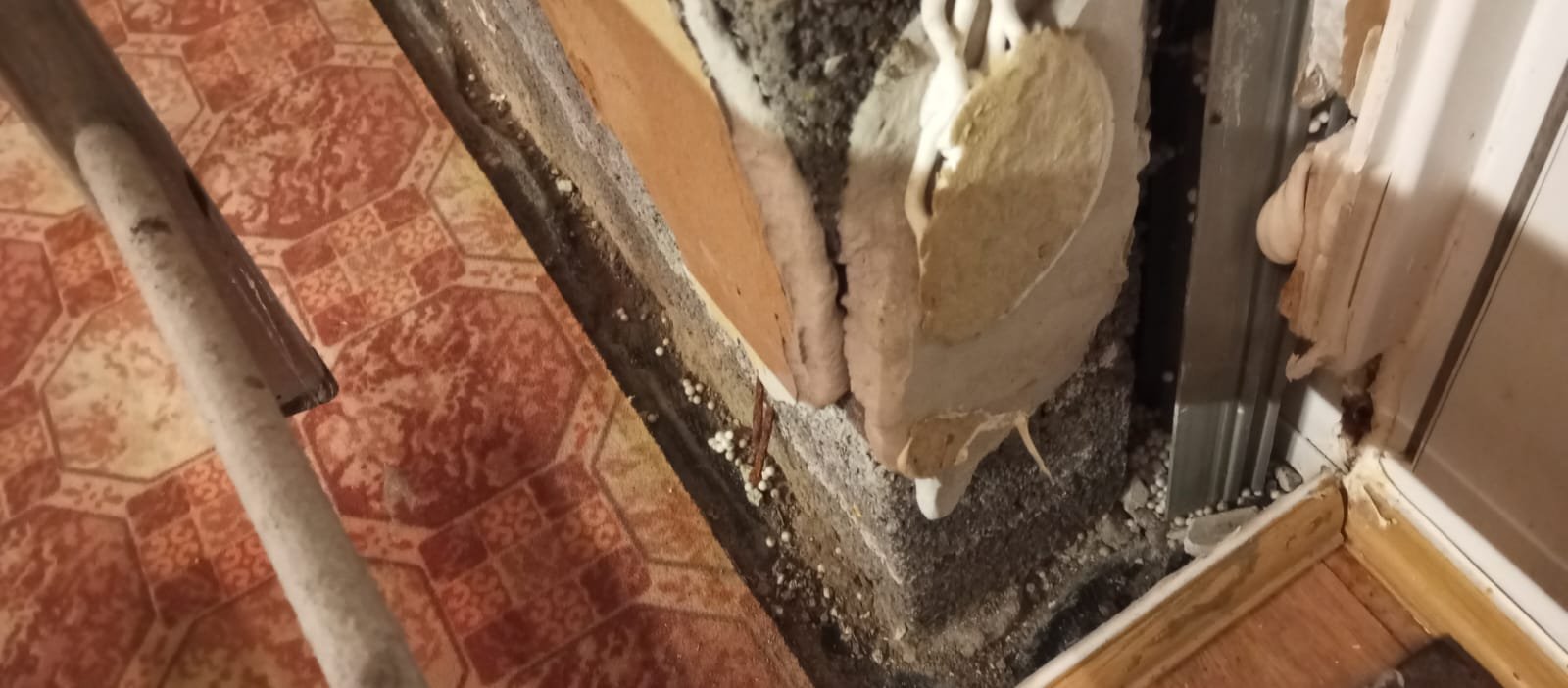


This is the fixed toilet area (that was previously boxed off hiding the leak before the replacement)
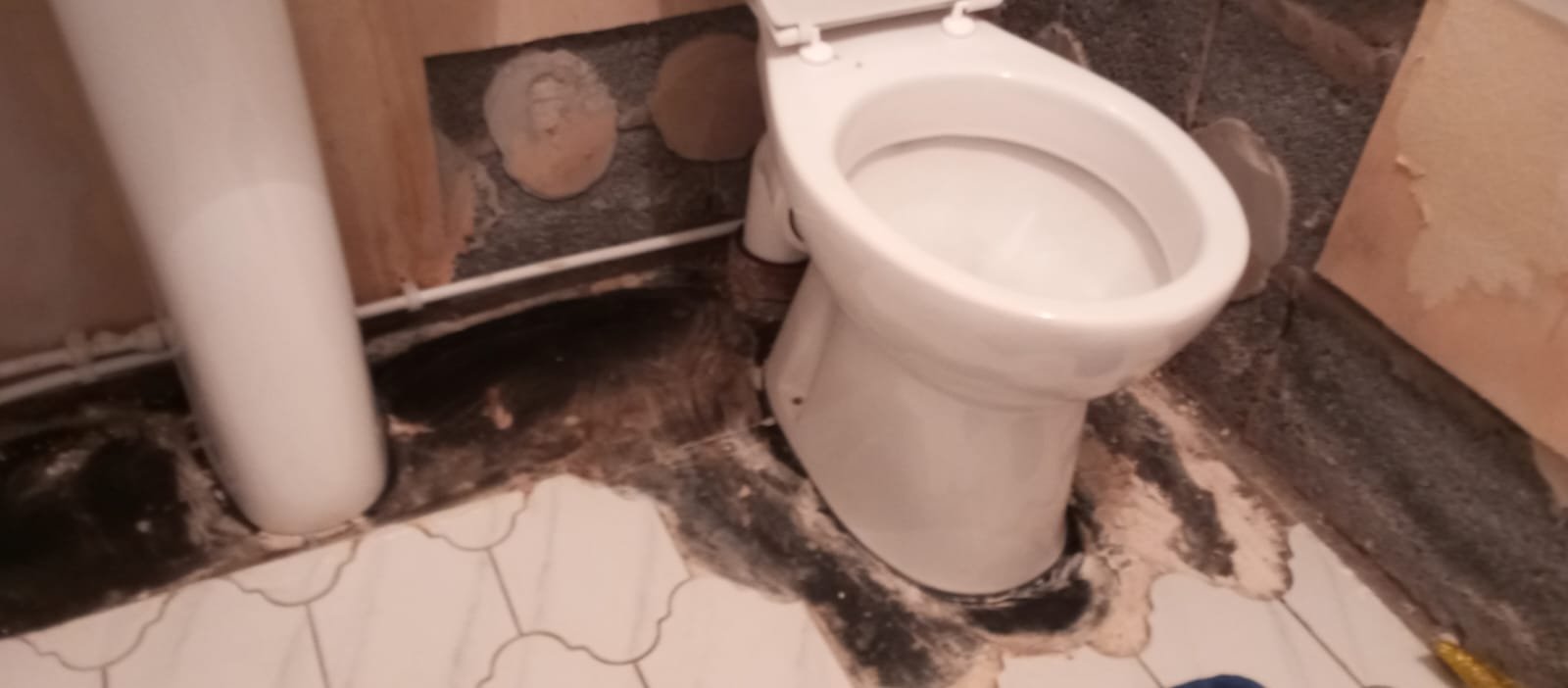
Random area where these packing balls have fallen with the material behind the plaster (potentially dangerous?) I cannot find the source of where they came from. Perhaps above, but the plaster seem ok there and didn't want to damage in case it was part of the symptoms.
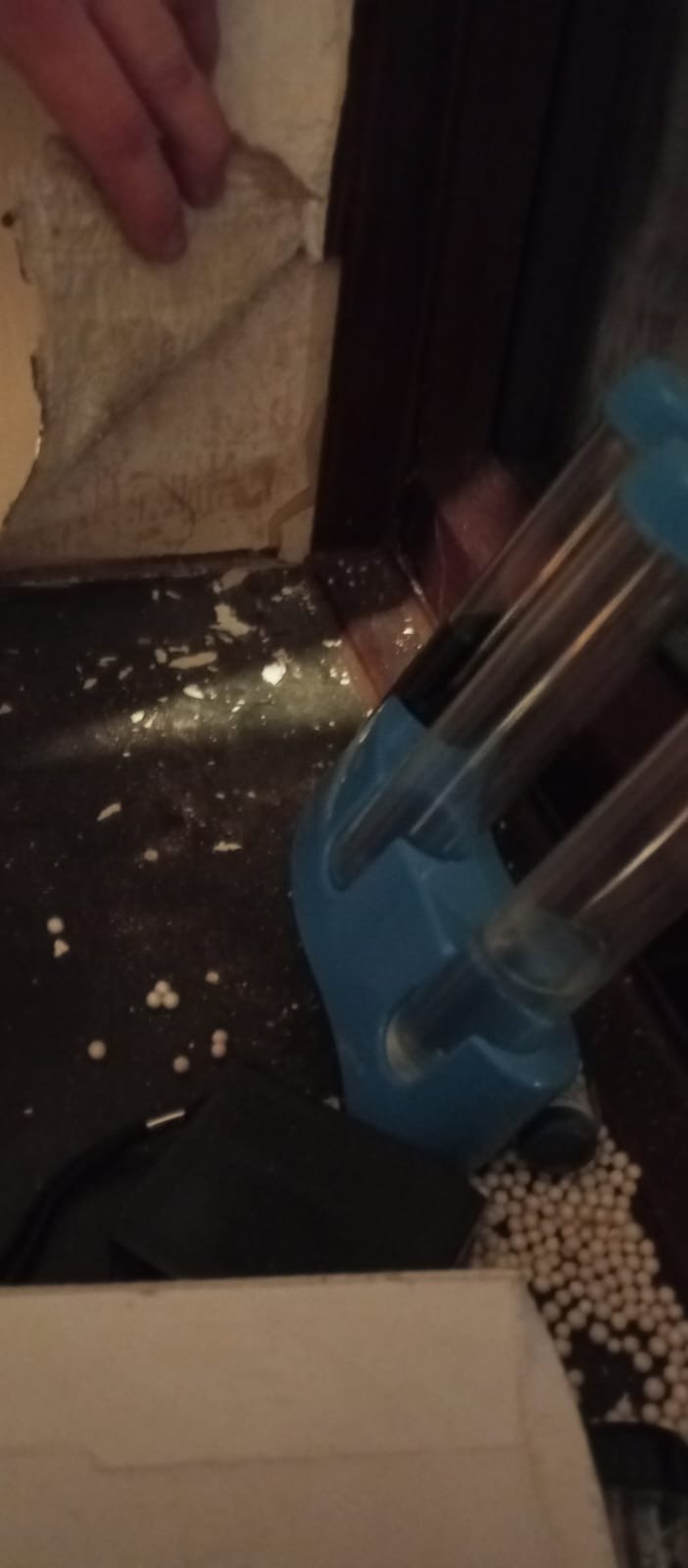
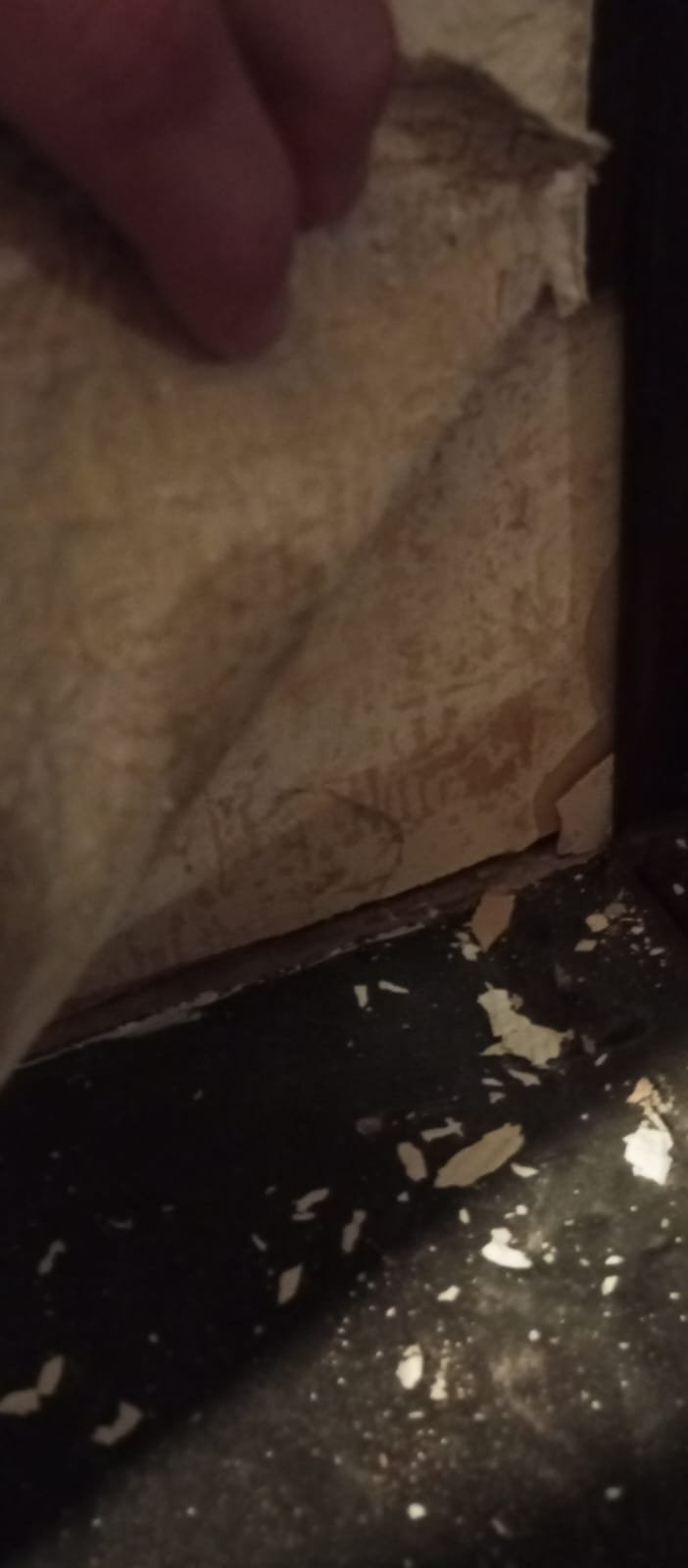
Packing balls in toilet, but appearing underneath an old bathtub. Lots can be seen under these wooden boards. Few tiles caved in at the top too, planning on having them fixed.
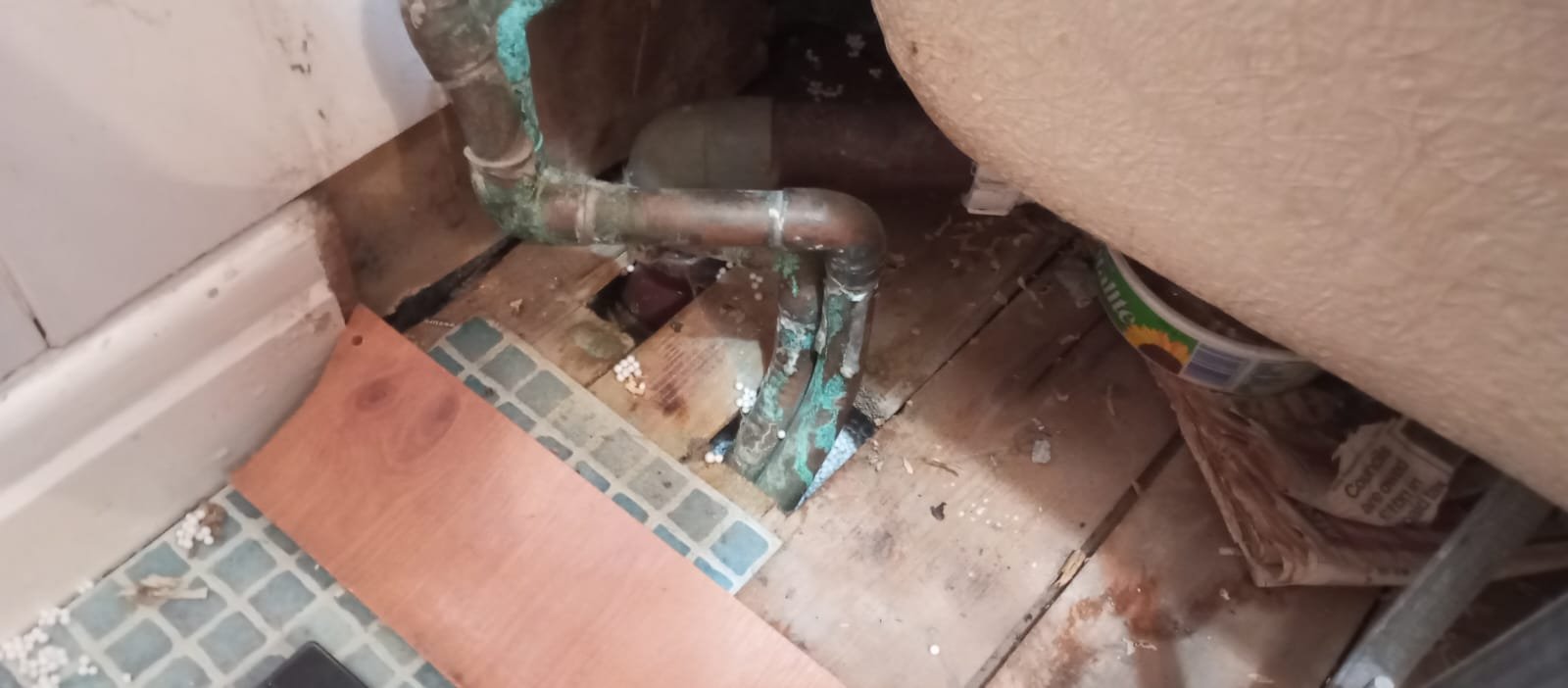
Essentially I am looking for the problem with breathing to be conclusively identified with empirical evidence. Whoever can supply that service I am searching.
Any identified materials that could be triggering my respiratory issues from the water damage that was caused?
Which message boards can I post this to find informed help, or who can I contact? With the mind fog and the past year, I am very tired. Direction is appreciated.
Are there any Govt schemes to help with this, if it is found that banned minerals like asbestos are found or other hazardous materials, particularly if they are inside the walls and undetectable from the interior?
After the past 12months I've had, I'd very much just like to breathe normally at home for a bit. All aid appreciated.
After the past 12months I've had, I'd very much just like to breathe normally at home for a bit. All aid appreciated.
Thanks
0
Comments
-
I am sorry you lost your dad.I can’t answer all your questions but the ‘packing balls’ are normally used in cavity wall insulation. They are made of some sort of polystyrene. I don’t think they are likely to affect your health. It’s very common to have them fall out if you have a small hole in your wall. We have had houses where they fall out with no ill effect.The grey looking blocks behind your skirting board are breeze blocks. Again they are very common in houses. Certainly every modern house will be built with breeze blocks. They are unlikely to cause any health risks.The wasps nest is unlikely to be causing any health issues. It’s basically cardboard. They will have died or left the nest before the winter. They won’t use it again. It won’t cause damp but it might hold damp in the place if it gets wet because it is cardboard.Most of the loft insulation looks fairly new and it is unlikely to cause any health problems but it does make your eyes itchy and your skin itchy but only when you have been touching it. Normally when I have been replacing insulation it is itchy for a day or two but it wouldn’t affect me if I just put my hand on it. The pipe insulation I don’t recognise. I would be careful not to touch that. Someone else might have a better idea but as a precaution I would not touch it.Damp and mould can cause health problems. You say you have fixed the causes of damp. Any mould needs to be washed off. Vinegar is normally recommended but there are products you can buy. It might be better to get some else to do it given your health issues. The products you can buy are horrible to breathe in and you don’t want to breathe in the mould so they should wear a mask. The rooms need ventilating and drying out with airing heating and perhaps dehumidifiers.All that aside have you been to see your GP about your symptoms. There may be a straight forward explanation of your symptoms that can be treated. Brain fog can be caused by lots of things eg infection, stress, menopause amongst lots of others.I have limited experience of testing indoor air quality but in my experience nothing has been conclusive at all. I would get the mould cleaned up and your health checked out by your dr and see where you are.1
-
Hi Henrta.
You've not had a good year 😔
May I ask how old your dad was on his passing? How old is the house? And for how long have you both lived there?
Was your dad otherwise in good health - was this sudden and unexpected? If so, was a post-mortem carried out?
And is/was your own health otherwise good? Do you manage daily fresh-air walks?
I have looked closely at your photos, and although I am in no sense an expert in these areas - tho' have had a life-long interest in houses and their construction - I have to say there is nothing of obvious concern there at all.
The wee beads look like cavity wall insulation, and will be escaping out from any gaps in the inner wall skin - seemingly from under floor level in the bathroom. That is very common, and there is no health issue I am aware of connected with these.
The same applies to things like the wasp's nest - I guess it's possible that some folk could be allergic to some of the products used in its construction - I'm guessing mainly wasp spit?! - but I've never heard of this, and it would be extremely unlikely to affect anyone in the main house in any case; the nest is small, in a ventilated loft, and is intact.
The loft insulation could be an irritant, and is for many folk in direct contact with it - hence installers will wear masks and overalls. The stuff can certainly itch, and I wouldn't want to breath it excessively, but virtually every house in the land has this in one form or another, and it's not known to be harmful (folk can correct me in this).
There's a pipe running across a larger grey soil pipe in your first pic, and this appears to be 'lagged' in the old-style 'felt' or horsehair or hemp material - essentially similar stuff to old string! Again, it can release fibres if actively disturbed, and some folk will find it itchy in contact, and it'll tickle their throats. But, again, it's in a ventilated loft, sits there passively, and I'm not aware of any actual health issues it can cause.
Then there's mould around your leaking toilet seat. Mould is connected with some respiratory problems, but in my opinion what you have on the floor surrounding the toilet is very localised and minimal. It was also presumably damp for most of the time it existed, and that would have likely prevented the nasty spores from getting into the air where it could contact folk. I need to emphasise that I'm no expert, but the mould looks both minimal and also most likely contained in that area.
I see nothing in any picture that suggests the presence of asbestos anywhere. If ceilings have been 'Artexed' at any time up until around the mid-80s (I think), then it could contain harmful asbestos, but this would only become a risk if it was carelessly disturbed - ceiling broken up, ripped down, or drilled and sanded. Also, the effects of asbestos is very long term forming from the time of exposure.
In short, Henrta, everything you've shown us looks perfectly standard and normal, with absolutely no 'red flags' to my (unprofessional, but pretty DIY experienced) eyes. If that were my house, I'd have no concerns about either living in it, or carrying out work on it. If course, different folk have different sensitivities to everyday products and materials.
As for your question of who can test this, I'm sure there are numerous companies who could, but their remit would have to be large, since you don't know what you are looking for. Ultimately, I'd have to suggest it is extremely unlikely that there is anything in your house that caused your father's, and now your, health issues.
Did you and your dad live in this house for similar or quite different lengths of time? Your dad's illness and your symptoms developed within the past year, so if there is a domestic 'cause', it must have been a fairly recent development? Apart from that toilet leak, have you had significant work carried out on the house such as ceilings being taken down? Even then...
I just cannot see any way the house is causing this.
If you take daily fresh-air walks, and wear a mask indoors, I think you could further eliminate the house as the cause. If you can, ventilate the house thoroughly whilst you are out - windows cracked open, and a nice through-flow. I'm not suggesting this as a way of continued living (apart from the daily walks!), but as a ~2-month test to help you hopefully be able to dismiss the house as being the cause.
I'm not a doctor, but am aware that COVID and its numerous variations can cause the symptoms you are experiencing, and very possibly what your dad went through. What was the reckoned cause of your dad's passing? Have you spoken to your GP about your symptoms?
All the best at finding a resolution.
1 -
Can't offer any advise on your respiratory issues - however the "packing balls" absolutely are just cavity wall insulation. They drill holes on the outside of the house, and pump (blow) them in with an adhesive. They do find any holes - which tends to be hidden under floors, in the loft, under baths and showers, behind skirting boards. The polystyrene is harmless, its the same as you'd find in bean bags or used as protective packaging.
Loft insulation is usually fibre glass - its horrible stuff that can irritate the skin - generally only temporarily, and certainly only if you've been working with it. If you're not normally in and out of the loft it will do you zero harm. If you do have need to touch it, wear gloves and long sleeves, and wear eye protection and a dust mask. As its in the loft, the loft will have settled with dust and this will be more harmful to you than the insulation.
From the pictures it is hard to tell - however as the insulation appears to be laid level to the joists, and not over them, this suggests is may only be 100mm deep. Modern standards are 300mm. Rolls of 200mm thick insulation are available to do a top up - its a simply job of rolling out over the existing. Whilst there are insulating firms, this is an easy DIY job or one for a handyman. DIY stores tend to stock insulation made of other products such as recycled clothes and sheeps wool which isn't as itchy/irritating as fibre glass.
You've made no mention to ventilation. As your house is insulated, that means moist air in the house will condense on any cold surface it finds - so the pipes (which is why they're green) and cold areas of the walls (cavity wall insulation is rarely 100% successful, and there could be odd gaps) - behind skirting boards is can happen as floors don't seal to the wall, so draughts can come up from under the floor cooling the wall behind the skirting. To counter this you *must* ventilate when cooking, washing and anywhere you sleep. Simply opening windows whilst cooking and showering will make a big difference. Otherwise humidistat extractor fan in the bathroom and an extractor for your cooker in the kitchen will make a big difference. A dehumidifier can also be a cheap option for the rest of the house and used through the winter months when you're not inclined to be opening windows a lot.0 -
Have you had the carbon monoxide levels checked?4
-
I agree with Stuart, that is something that can get checked and will be reassuaring.Having had a through examination you've done a good job at eliminating most things. I'd suggest getting any damp dried out, mould washed off with vinegar as the least likely to cause any reaction. It's cheap in most diy shops.The re fix the skirting close, fill in any gaps with silicone to prevent draughts and keep dry.Everything you have there, I have or have had so quite normal. The insulation beads will come through any holes in the wall when they are pumped in. I used to have them in a small loft on an extension because it wasn't sealed when done.Make sure any air bricks outside are clear. Sometimes the beads will get in there or things grow around them.Check that no soil has been stacked against the walls outside. That can hold damp. And that nothing is around/above your damp proof course.What does a doctor say about your respiratory symptoms? You have been under a lot of stress recently and this on going anxiety is going to impact on your health. Taking the place apart, while good to eliminate problems, is now probably not making you feel any better. Replace, make it a home again where you can relax.

I can rise and shine - just not at the same time!
viral kindness .....kindness is contageous pass it on
The only normal people you know are the ones you don’t know very well
0 -
stuart45 said:Have you had the carbon monoxide levels checked?Good thought. If there are any gas/oil/coal/wood burners in the house, get a carbon monoxide alarm and install it near the appliance - read the manufacturer's instructions.British Standard ones aren't all that sensitive. If one goes off, you are being poisoned and need to do something about it immediately.If it sticks, force it.
If it breaks, well it wasn't working right anyway.0
Confirm your email address to Create Threads and Reply

Categories
- All Categories
- 352.9K Banking & Borrowing
- 253.9K Reduce Debt & Boost Income
- 454.7K Spending & Discounts
- 246K Work, Benefits & Business
- 602.1K Mortgages, Homes & Bills
- 177.8K Life & Family
- 259.9K Travel & Transport
- 1.5M Hobbies & Leisure
- 16K Discuss & Feedback
- 37.7K Read-Only Boards


